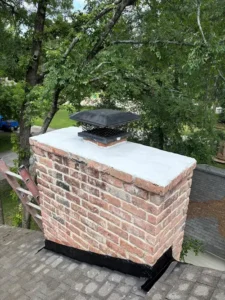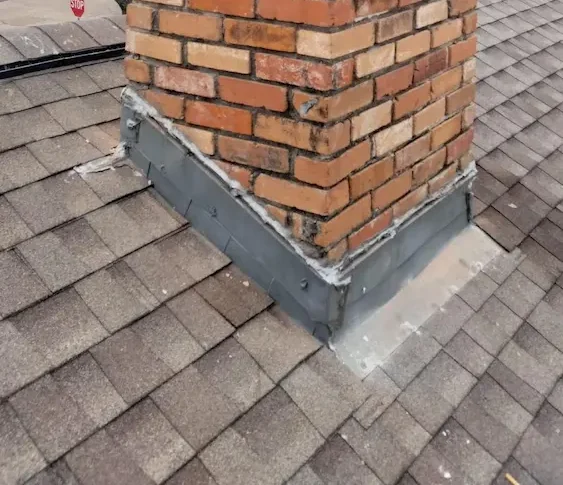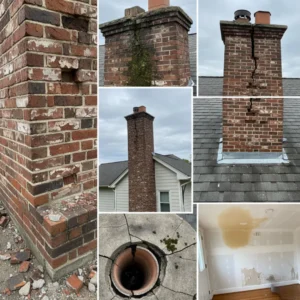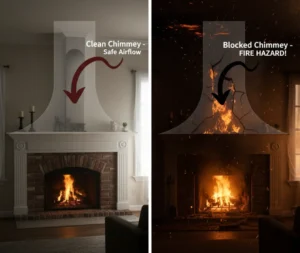
A well-functioning chimney is more than just a passage for smoke—it’s a vital component of a home’s ventilation system. While homeowners often focus on cleaning and maintaining the chimney flue, one critical yet often overlooked part is the chimney flashing. This thin, protective barrier is responsible for preventing leaks where the chimney meets the roof, safeguarding the home from costly water damage.
Understanding Chimney Flashing and Its Importance
Chimney flashing is the sheet metal installed at the base of a chimney where it intersects with the roof. It creates a watertight seal, preventing rainwater from seeping into the structure. Typically, flashing consists of two main parts: the step flashing, which is layered under the roofing material, and the counter flashing, which overlaps the step flashing and is secured into the chimney masonry. When installed correctly, these components work together to divert water away from the vulnerable seam between the roof and the chimney.
Without properly functioning flashing, moisture can enter the roof decking, insulation, and even the interior walls, leading to mold growth, wood rot, and structural damage. Since water damage often goes unnoticed until it becomes severe, ensuring the integrity of chimney flashing repair is essential for maintaining a home’s overall health.
Signs That Your Chimney Flashing Needs Repair
Over time, even the best-installed flashing can deteriorate due to exposure to the elements. Temperature fluctuations, storms, and natural aging can cause it to warp, crack, or become loose. Recognizing the signs of faulty flashing early can save homeowners from costly chimney repair down the road.
Water Stains on Ceilings or Walls
One of the most common indicators of chimney flashing failure is water stains on ceilings or walls near the chimney. If you notice discoloration or damp patches, it could mean that water is infiltrating the home due to compromised flashing.
Rusted or Warped Flashing
If the metal flashing appears rusted, warped, or detached, it is no longer providing a proper seal. Harsh weather conditions, especially in regions with heavy rainfall and strong winds, can accelerate wear and tear on flashing materials.
Mold or Musty Odors
Moisture buildup creates the perfect environment for mold growth. A persistent musty odor in your home, particularly near the chimney, may indicate hidden water damage caused by failing flashing.
Cracked or Missing Mortar Joints
Since counter flashing is embedded into the chimney masonry, deteriorating mortar joints can lead to gaps where water can penetrate. If the mortar around your chimney appears cracked or missing, it’s a sign that your flashing system may need attention.
Why Chimney Flashing Fails and What You Can Do About It
Flashing failures can occur due to several factors, from poor chimney installation to natural aging. Understanding the root causes can help homeowners take preventative measures and seek timely repairs.
Improper Installation
One of the leading reasons for flashing failure is improper installation. If the flashing wasn’t fitted correctly or the sealant wasn’t applied properly, water can find its way into the home. Hiring experienced professionals ensures the job is done right the first time.
Weather Damage
Strong winds, heavy rain, and snow can gradually weaken flashing materials. Over time, constant exposure to the elements can lead to gaps, cracks, and warping. Regular chimney inspection, especially after extreme weather conditions, can help detect issues early.
Aging and Corrosion
Like any material, flashing has a lifespan. Over the years, the metal can corrode, crack, or separate from the chimney structure. Homeowners with older homes should pay extra attention to their chimney flashing to prevent costly water damage.
Shifting Roof or Chimney
Structural movement can also contribute to flashing problems. As houses settle over time, slight shifts in the roof or chimney can cause the flashing to pull away, breaking the seal and allowing water infiltration. Seasonal freeze-thaw cycles can exacerbate this issue.
Preventative Maintenance and Repair Options
Routine level 2 chimney inspection and maintenance are key to ensuring chimney flashing remains in good condition. Addressing minor issues before they escalate can save homeowners significant time and money.
Regular Inspections
Experts recommend inspecting chimney flashing at least once a year or after severe storms. Checking for loose or damaged flashing, rust, and deteriorating mortar can help identify problems early.
Re-Sealing or Replacing Flashing
If the flashing is still intact but has minor gaps or cracks, applying a high-quality waterproof sealant can help restore its protective barrier. However, if the flashing is severely damaged or rusted, chimney flashing replacement may be the best solution.
Professional Repairs
For long-term reliability, professional repair or replacement is often the best course of action. An experienced technician can ensure that the new flashing is securely installed and properly sealed, providing maximum protection against water intrusion.
Common Materials Used for Chimney Flashing
When it comes to chimney flashing, the choice of material plays a significant role in its durability and effectiveness. Several materials are commonly used, each with its own benefits and drawbacks.
Aluminum Flashing
Aluminum is a popular choice due to its affordability and resistance to rust. It is lightweight, easy to work with, and ideal for homes in areas with moderate weather conditions. However, it can corrode over time if not properly coated or maintained.
Copper Flashing
Copper is one of the most durable options available. It is highly resistant to corrosion and can last for decades with minimal maintenance. While it is more expensive than other materials, its longevity and aesthetic appeal make it a preferred choice for many homeowners.
Galvanized Steel Flashing
Galvanized steel is another commonly used material for chimney flashing. It is strong and durable, but it requires proper coating to prevent rust. If the coating wears off, the steel may begin to corrode over time.
Lead Flashing
Lead is extremely malleable, allowing for a tight and custom fit around the chimney. It is also highly resistant to weather-related damage. However, it is more expensive and requires careful handling due to potential health concerns.
DIY vs. Professional Chimney Flashing Repair
Some homeowners may attempt to repair chimney flashing on their own, but this is often a challenging and risky task. Climbing onto the roof and working with metal flashing requires specialized knowledge and tools.
The Risks of DIY Repairs
DIY repairs can sometimes do more harm than good. Improper sealing, incorrect placement of flashing, or using the wrong materials can lead to ongoing water damage and costly repairs in the future. Additionally, working on the roof poses safety hazards, especially for those without experience.
The Benefits of Hiring a Professional
Professional chimney repair specialists have the expertise to diagnose and fix flashing issues efficiently. They can ensure that the materials are properly installed, sealed, and secured to withstand the elements. Investing in professional repair services helps homeowners avoid recurring problems and potential structural damage.
Stay Ahead of Chimney Maintenance
Keeping your chimney in top shape goes beyond occasional cleaning—it requires attention to critical components like flashing. By addressing potential issues early, homeowners can prevent costly chimney leak repair and maintain the longevity of their roofing system.
For expert services in chimney repair Houston, be sure to follow our blog for regular updates, maintenance tips, and professional insights. Stay tuned for more ways to protect and enhance your home’s chimney system!





